Brick stoves for giving on wood: the best orders and a step-by-step guide to the construction
Most domestic holiday villages do not yet have the opportunity to connect to centralized communications. From the infrastructure it is good if there are paved roads and electricity lines. In such conditions, the construction of a brick oven for giving wood-burning will help to solve an important problem: it will provide thermal energy for heating rooms and for cooking.
We have selected for you the schemes and orders of the simplest furnace designs, with which the novice master can cope with the masonry. With our help, home craftsmen will easily learn the basics of the difficult, but extremely interesting activity of the stove-maker. An impeccably constructed structure will delight both the owner and the household.
In addition to a detailed description of the technology of laying brick stoves, we provide valuable recommendations on the selection of materials for the construction of units. The article meticulously spells out the significant subtleties and the smallest nuances. To help independent stoves, schemes of furnace structures, serial instruction, photos and video manuals are attached.
The content of the article:
Materials for the construction of a brick stove
Proper selection of material for a building subjected to high-temperature effects is an important part of the work of a prepared stove. After all, the unit will be operated in far difficult conditions, while it should not give malfunctions, crack and collapse.
There is a mass furnace designs. Despite the differences in their arrangement, the same types of materials are used for masonry brick ovens. The differences in their selection depend only on the operation of the structural component for the device of which they are intended.
In order to determine the purpose and location of these same components, we briefly describe them.
As an independent construction, a brick oven includes:
- Foundation. A support structure buried in the ground or arranged in a dry underground, made of rubble stone or brick. For small cottage stoves, the foundation is often made monolithic from reinforced concrete.
- Array This part of the brick kiln includes the unit body together with the furnace, stove appliances and smoke flues - brick channels laid out in the kiln body to increase heat transfer. In addition, a lining is performed inside the firebox - lining made of heat-resistant bricks.
- Chimney. The brick oven is equipped with a channel folded from the same material, because only he can transport flue gas with temperatures up to 500-700º without destruction. Instead of bricks, you can use ceramic blocks.
Steel and asbestos-cement pipes are not suitable for arranging chimneys of brick kilns. They “burn out” in a couple of years, and therefore require regular replacement.
The listed parts of the furnace perform different functions, experience an ambiguous load and the degree of temperature exposure. Therefore, for their device they use different brands of brick and different binder compositions.
For laying a brick stove, the following materials will be required:
- Red solid brick. It is needed for the construction of the stove with smoke, cutting and the outer part of the furnace. It will take fired first-class brick, the technical qualities of which are regulated by GOST 530-2012.
- Refractory refractory brick. This brick is used for lining the stove firebox and laying the “hearth” - the foundations of Russian stoves. The technical quality of the refractory material is regulated by GOST 8691-73.
- Sheet roofing steel, asbofaner, tiles (clinker facing tile, tile). These materials are needed for the outer lining of the portal of the stove.
- Heat-insulating fireproof materials. These are asbestos-cement slabs, mats from mineral wool on a synthetic basis, asbestos board, building felt with impregnation of clay diluted in water. The listed materials are required for flame retardant insulation and cladding.
To perform insulation and cladding, it is unacceptable to use heat-insulating materials, which include bitumen or bitumen-containing ingredients.
Brick for laying the stove should be carefully selected, carefully check each unit for cracks, chips, sinks, extraneous inclusions. All elements must be uniformly painted and burned.
Used brick, cleaned of mortar after dismantling the destroyed buildings, may be used in masonry parts of the unit that are remote from the furnace. For example, it is quite suitable for the device of the lower rows of the furnace foundation.
It is not allowed to use masonry brick contaminated by furnace condensate obtained when dismantling old stoves.
The composition of the binder materials used in the masonry of a heating or cooking-heating construction made of brick is also ambiguous.
The following solutions will be required:
- Clay sand solution. It is needed for the construction of the main working part of the structure - the furnace massif.
- A mixture of refractory clay with sand. It is required when laying refractory bricks, for example, during the construction of the cooking section, compartments for the built-in boiler or recess for the oven.
- Fireclay masonry mixture. Composition of refractory clay with sifted mountain sand. It is used when laying refractory bricks, i.e. when lining the firebox or when installing the base of the furnace of a Russian stove.
- Lime-cement or lime-sand mortar. It will be needed in the device part of the chimney, located within the attic.
- Cement or lime-cement mortar. It is necessary during the construction of a part of the chimney that rises above the roof.
The composition of the binder solution used in the construction of foundations under the furnace depends on the moisture content of the surrounding soil. If the base is buried in low-moisture rocks, a lime-sand solution will be required. To build a foundation in wet soils, you need a cement mortar.
The clay-sand mixture is prepared independently, although there are now a lot of ready-made masonry compounds on sale, including a mixture of kaolin or red clay with sand.In self-preparation, the clay content should be taken into account, i.e. the presence or absence of tangible grains of sand in it.
Fine clay is dominated by finely divided particles; in lean clay there is sand, which reduces the ductility of the rock. Sand cannot be added to lean clay at all. The ratio is usually selected empirically, mixing rocks and achieving optimal plasticity of the solution.
When using fatty clay, the proportions of it and sand in the mixture can reach 1: 4, but no more. Less may well be. The proportion of sand usually varies, the proportions are selected on the object so that the solution does not crack and does not change in volume when it dries.
A solution of clay with sand, intended for self-laying the stove, is prepared in advance. Not more than a day, but not less than three hours. Natural ingredients must be prepared for kneading. Sand must be sieved through a sieve with cells up to 1.5 mm, the clay should be wiped through a mesh with cells up to 4 mm. In the prepared mass there should not be organic inclusions.
When using factory-made building mixtures in the manufacture, they exactly follow the instructions supplied by the manufacturer to their product.
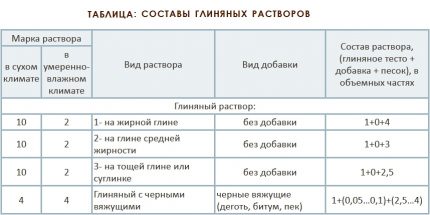
Solutions for laying a brick stove are prepared in the amount necessary for work. It makes no sense to shut more, because after drying they can not be “rejuvenated”, i.e. dilute with water to its original consistency.
The percentage of home-made clay-sand mortar used in the construction of the furnace array must be remembered. After construction, the furnace is finished with the same composition, if it is decided not to leave the building without decoration.
Arrangements to help independent stove-makers
In the selection of the design of the country stove there are many nuances that can not be ignored. The overwhelming majority of wood aggregates in dachas do not constantly heat, which is not the best way affects their functionality and performance.
Due to the limited free space in the country, they try to build a stove alone. They prefer mainly universal designs with both a heat-conducting surface and cast iron. hotplate for cooking food. Although there are adherents of pure heating units.
We will analyze three options for the construction of brick stoves for summer cottages, the construction of which is quite possible to cope with your own hands. Consider the universal and heating structures of an extremely simple device, which even with an irregular firebox can be quickly and easily cleaned.
The most popular types of brick stoves can be found in this stuff.
Option # 1 - stove with a single burner panel
This is an extremely simple and compact design, as if elongated in the vertical direction. In the example, it is equipped with a door with heat-resistant glass that allows you to monitor the process. If it is not possible to purchase just such a door, a cast iron version is quite suitable.

The width of the small-sized brick structure is 510 mm, which allows it to be placed without problems in traditionally small country houses. The depth of the stove is 640 mm, while the depth of the furnace does not exceed 500 mm. The height of the structure is 2150 mm, the height of the chimney is determined by the position of the pipe relative to the ridge.
An oven is provided, which can be replaced with a drying chamber or a hot water tank. The presence of functional compartments not only allows you to prepare delicious hot dishes at the cottage, but also increases the heat transfer of the brick structure.
Heated air and flue gases during operation of the stove rush up, pass along the rear wall of the cooking compartment, and then flow into the chimney sweeps and further into the chimney. Thermal energy in this building is used to the maximum.
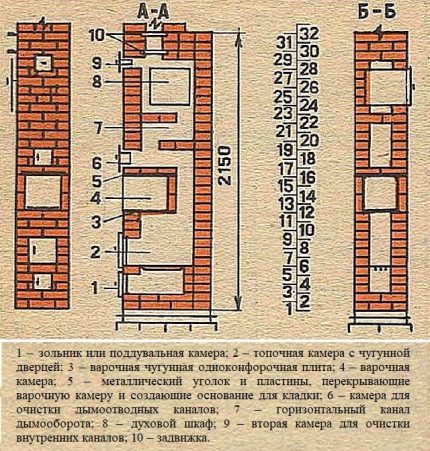
The described brick structure includes 31 rows of flat laid bricks. In order for the design to function flawlessly, the following orders should be strictly observed.
During masonry, it is necessary to constantly check the horizontalness of the structure being constructed and to check the diagonal size of the laid sides. There are strict requirements for the thickness of the seams, which must be strictly considered. The maximum thickness of the seams when laying the body and chimneys cannot exceed 5 mm, while lining - 3 mm.
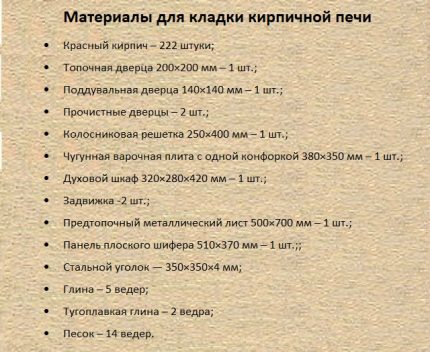
In the presented order, the foundation for the stove, the specifics of the construction of which is presented, is not indicated in another article on our website. It is poured or built of brick according to standard rules. We assume that the foundation has already been erected, and proceed to the direct laying of the stove.
There are no comments needed for laying the first three rows; everything is extremely simple there. In the 3rd row we put the door for the blower, in the 5th we put the grate. In front of the 6th row device, we put the furnace door: temporarily fix the frame with the door with wire extensions and immediately support it with two side bricks.
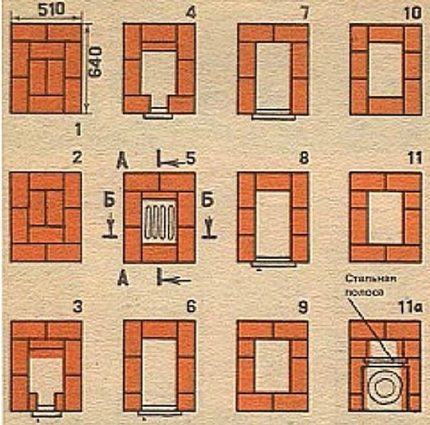
Next, follow the orders of the order up to the 11th row. After laying it, we lay a metal corner or steel strip, stepping back from the rear edge of the already constructed part of the structure exactly the width of one brick. This is necessary to install the hob.
After installing the hob, we continue laying, strictly following the instructions of the orders.Starting from the 12th and following to the 15th row, we simultaneously build the walls of the rear smoke channel and the cooking compartment.

At the end of the laying of the 15th row, we put metal corners or put a slate sheet. They will serve as the basis for the upcoming continuous masonry.
In the 17th row, we put and fix the door of the cleaning chamber. We spread it up to the 22nd row. The result should be a hollow section connected to the smoke channel.
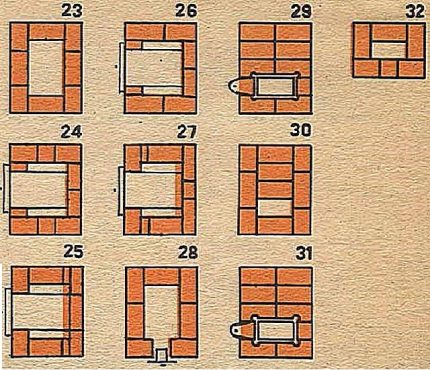
In the 24th row along the inner edges of our design, we lay out asbestos scraps. Next, we wrap the oven case with an asbestos rope, after which we put it on the stove, resting on the scraps. Asbestos rope will perform the function of thermal insulation, and at the same time protect the device from burnout.
From the 24th to the 27th row, we cover the oven with bricks, observing the thickness of the seams regulated by the rules.
In the 28th row we put the door through which we will clean the chimney. We fix it as it should with two bricks on the sides and continue the construction.
In the 29th and 31st rows we arrange channels for chimney valves. We simply stack them and carry out further masonry, without binding the devices to the bricks with a solution. Then from the 32nd row we build a chimney.
Option # 2 - an oven for heating adjacent rooms
This design is unconditionally attributed to heating units. It is not equipped with a hob with hobs and an oven. But it perfectly warms up several adjacent rooms, in which it is part of the interior partition.
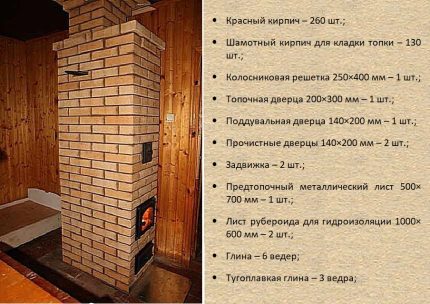
The design, like the previous type, is compact due to its elongation in height. It takes only 510 mm in width and 890 mm in depth.
The height of the heating stove without a chimney is 2380 mm, which is equal to 35 rows of stacked bricks.
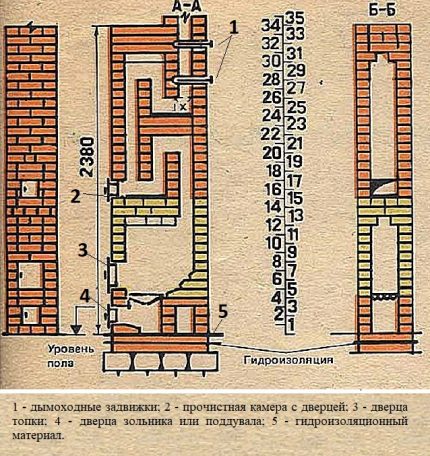
We will divide the order guide for laying a heating type of a country brick stove into three conventional parts. We assume that the foundation for it has already been erected in accordance with the general rules.
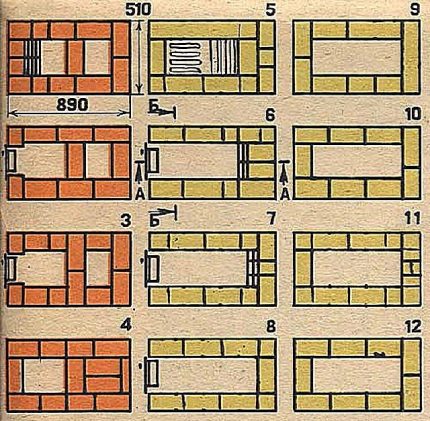
The first third shows the ordering schemes from the 1st to the 12th row. We start the starting rows with special care, as we will focus on them in the future. In each row we check the equality of the diagonals, we control the verticality of the rows with the building level.
In order for the walls to be strictly horizontal, we will periodically check them during masonry plumbing. In case of deviation, you need to immediately correct the errors until the solution has time to set and begin to harden.
Laying of the 1st row is carried out according to a roofing material, roofing felt or similar waterproofing material, laid in two rows. For convenience, we fix the waterproofing with a binder solution and mark the outline of the stove under construction on its surface.
In the 2nd row we put a frame with a blower door and proceed to the construction of the chimney. In the 5th row we put the grate, which is the overlap of the blower. In the 6th row, we put a frame with a furnace door and fix it immediately with two bricks on the sides.
From the 5th to the 15th row, the masonry is carried out with fireclay refractory bricks, so that you can not carry out the lining, which would essentially reduce the volume of an already small firebox.
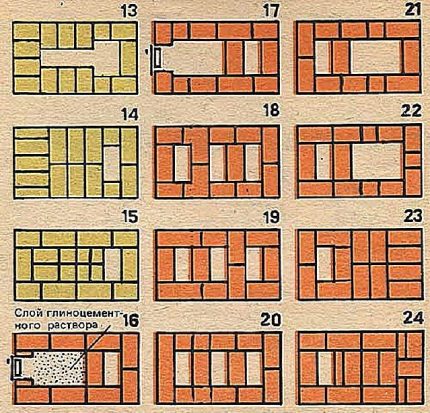
After laying the 16th row in the formed recess in the 15th row, we strengthen its bottom with a cement-sand mortar.
This is necessary to strengthen the bottom of the chamber, designed to clean the smoke channels. Then in the 16th row we put the cleaning door.
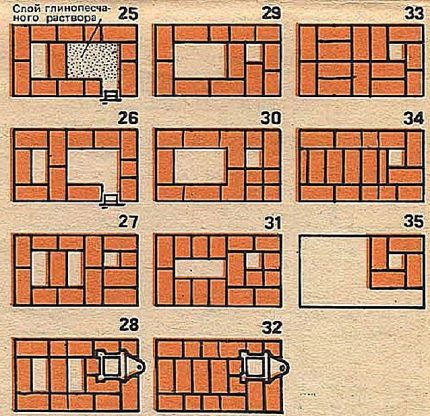
After we surround the cleaning door and form this chamber, at the same time we continue to build vertical channels for the chimney down to the 24th row.
Next, proceed to the third stage of masonry. In the 25th row, we begin the construction of a second cleaning chamber. Again, we strengthen the bottom of the previous row with a clay-cement composition, put another door and continue to build a chimney.
In the 28th and 32nd row, we lay the valves that are used as draft regulators. We report the furnace array up to the 35th row, so that after it we proceed to the construction of the chimney.
Option # 3 - a stove with a shield and a low trestle bed
A very practical design with a low brick bench, which serves in a Russian hut as a heated sleeper. The construction is more complicated than the previous options, but more practical, because It includes a heating unit, and partially furnished, and a hob.
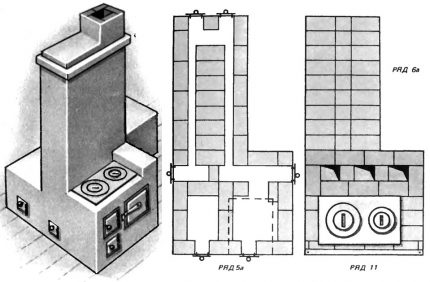
In order for the shield of the heating part of the stove to be 1020 mm wide, protrusions are formed on both sides. If you plan to increase heat transfer, the number of chimneys can be increased to 5 pieces. For the normal operation of this design, be sure to turn the chimneys above the stove.
This stove has two solutions, the differences of which are determined in rows 5 and 6, as well as in 5a and 6a. The second solution involves installing a steel corner at an angle.

Dimensions of the couch are selected individually. It may not be a solid brick structure with chambers for heating and cleaning, but a kind of trestle on pillars instead of legs.
Between the posts you need to leave holes with a width of 120 mm. However, a construction with cameras retains heat better.
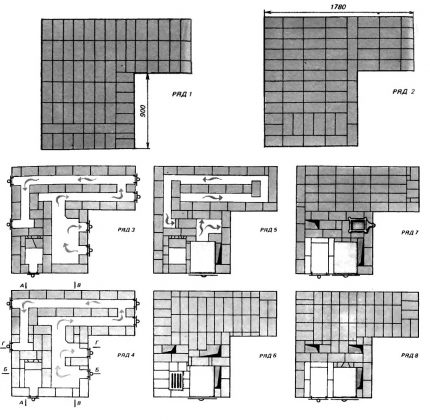
It is recommended to build this furnace on a monolithic foundation, on which asbestos sheet is laid before the construction of the furnace. Fireclay refractory brick is used only in the arrangement of the furnace as a lining. Typically, the firebox is built one brick below the installation level of its door.
The lining is carried out with a brick mounted on a rib. The orders given for the construction of this stove will not be described in detail, because the reader has already received ideas about the conventions and the specifics of the construction of stoves.

It is important to observe the given ordinal schemes, as well as clearly adhere to the proportions and compositions of the binder solutions used in the construction of brick stoves.
Conclusions and useful video on the topic
Video # 1. A clip to help independent stoves, the material is a visual order of the heating stove:
Video # 2. A detailed guide to the construction of a heating and cooking unit according to ready-made procedures, but with some changes from the contractor:
When choosing a design for the construction of a stove for a summer residence with your own hands, you need to consider your own capabilities and skills.It is possible that someone would consider the options we proposed to be too complicated or simple. In any case, the information presented will help to get an idea of the furnace structures in order to use it yourself or to monitor the actions of the hired stove-makers.
If you had to independently build a brick stove for a summer residence, please share photos of your own designs. Perhaps you know some subtleties that we did not take into account in our article? Tell our readers about them - leave comments in the block below.

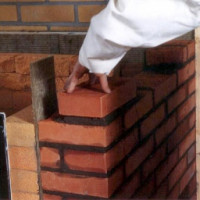 DIY masonry: a detailed guide + orders with diagrams and drawings
DIY masonry: a detailed guide + orders with diagrams and drawings 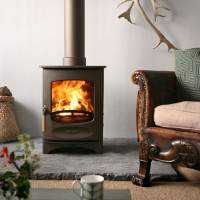 Wood-burning heating stoves for summer cottage: TOP-12 + tips for choosing equipment
Wood-burning heating stoves for summer cottage: TOP-12 + tips for choosing equipment 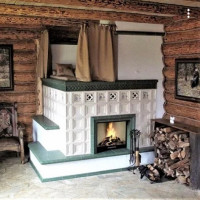 DIY do-it-yourself stoves: construction manuals with diagrams and procedures
DIY do-it-yourself stoves: construction manuals with diagrams and procedures 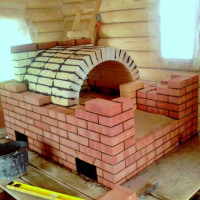 How to build a Russian stove: do-it-yourself masonry, the best orders and schemes
How to build a Russian stove: do-it-yourself masonry, the best orders and schemes  Do-it-yourself mini Russian stove: specifics and arrangements for the construction of a compact stove
Do-it-yourself mini Russian stove: specifics and arrangements for the construction of a compact stove 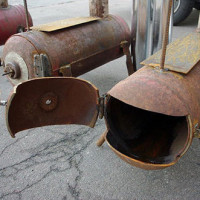 Do-it-yourself gas stove from a gas cylinder: diagrams, drawings + step-by-step guide
Do-it-yourself gas stove from a gas cylinder: diagrams, drawings + step-by-step guide  How much does it cost to connect gas to a private house: the price of organizing gas supply
How much does it cost to connect gas to a private house: the price of organizing gas supply  The best washing machines with dryer: model rating and customer tips
The best washing machines with dryer: model rating and customer tips  What is the color temperature of light and the nuances of choosing the temperature of the lamps to suit your needs
What is the color temperature of light and the nuances of choosing the temperature of the lamps to suit your needs  Replacement of a geyser in an apartment: replacement paperwork + basic norms and requirements
Replacement of a geyser in an apartment: replacement paperwork + basic norms and requirements
A brick oven is, of course, a classic. But as for me, an absolutely useless waste of money and time. Not only does it require careful design, but there is not much sense. At the dacha, I still solved the heating problem differently - I installed heaters, it’s cheaper at times and the heat supply can be precisely controlled, you do not need to clean the chimney and constantly buy firewood.
Is there a little sense from the brick stove? What are you? A well-made brick oven warms up for a long time, but if it is already heated, it keeps the heat very well - up to 24 hours. In comfort, it definitely surpasses, for example, a cast-iron stove. And what kind of heaters are cheaper at times? Electric? You will pay once for the stove, and then, firewood is much cheaper than electricity. The only problem is to find a good stove-maker, not so many of them.
Hello. Let me disagree with you. Count. We will consider it taking into account permanent residence, because we do not know how much time you spend there.
Kamaz ready firewood for the stove costs 10 thousand rubles. This is enough for heating for 5-6 months, subject to a solid structure, without special gaps and holes. Not counting how many people give wood for free (by the way, they also scoop up coal from sheds, they give away a lot) and the fact that from this year it is allowed to collect deadwood and dead wood in the forest.
We take a heater, but one is not enough for the house, but let it be one (it is more advisable to install then water heating with an electric boiler). Consumption on average 2 kW / h. 24 hours a day. 24x2 = 48 kW. Electricity prices from 2 rubles to 8 in different regions of the country. Let it be 3 rubles per kW. 48x3 = 144 rubles per day or 4320 rubles per month. We counted firewood for six months, even for 5 months, okay. 4320x5 = 21600. Without the ability to pick up somewhere for free.
We also take into account that the stove burned out, it was closed, it continues to warm. Heater turned off - it is ice.
Plus, there are heating and cooking stoves. You can heat and warm water at the same time or cook food. An additional device is required with a heater; again, this is the cost of bottled gas or electricity.